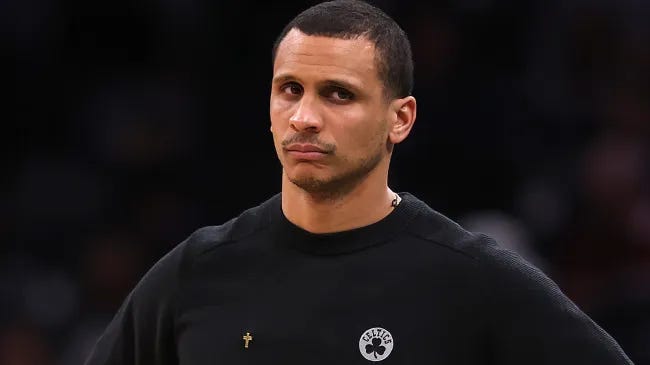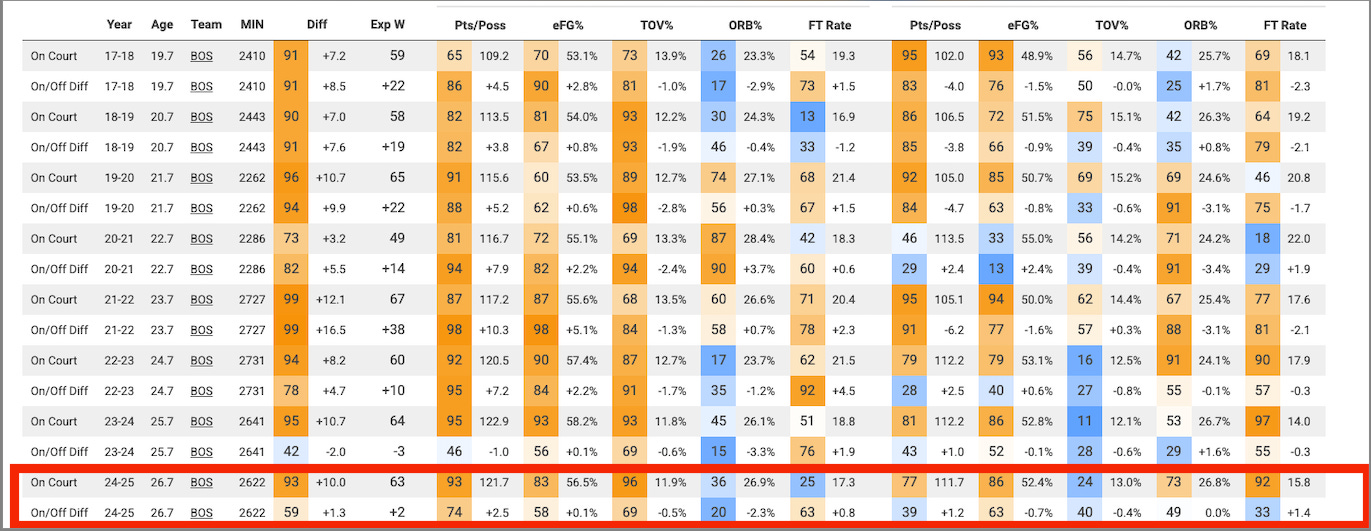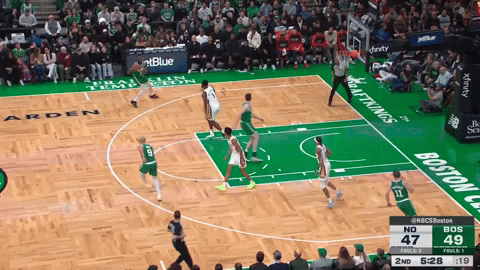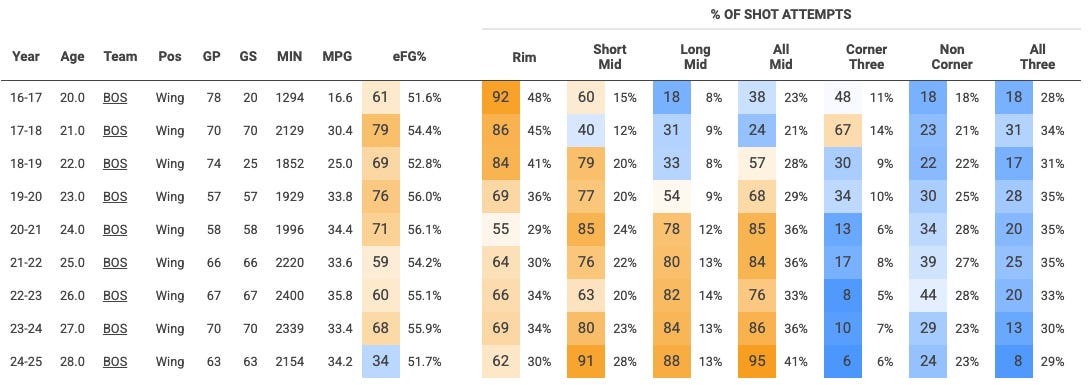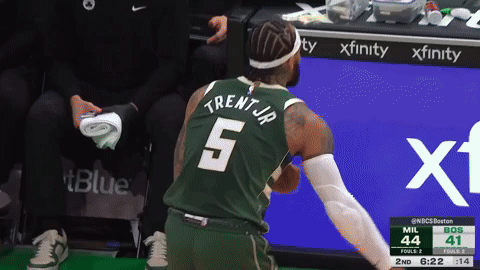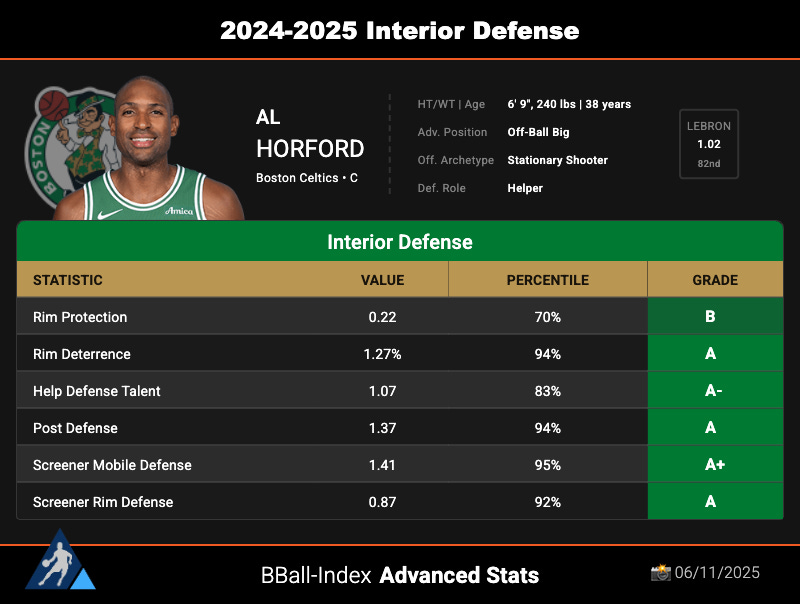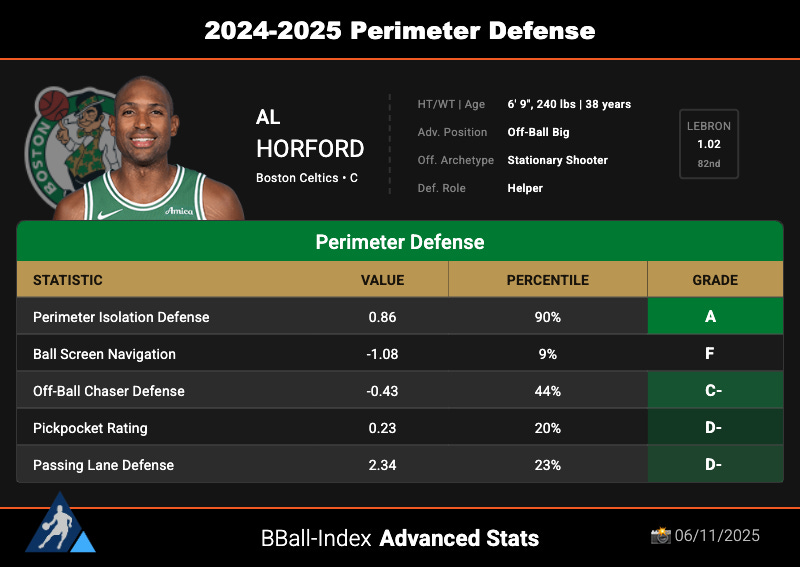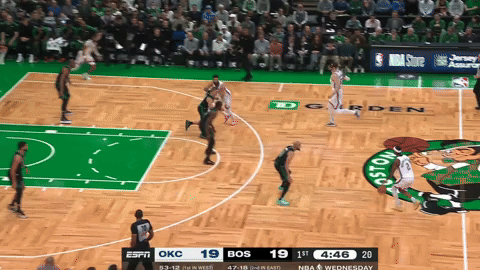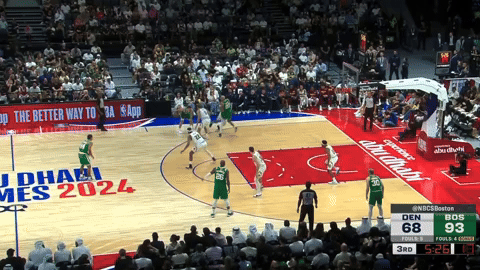Boston Celtics Player Grades: Forwards
It was a strong season for the forward rotation
Last week, we graded each member of the Boston Celtics guard rotation based on their production and performance in the 2024-25 season. Today, we’re focusing on the forwards.
Let’s dive right in.
Jayson Tatum: A+
Brutal.
I don’t know what other adjective to use to describe the scenes that took place when Tatum went down against the New York Knicks. That Achilles tendon injury is going to dictate a lot of what Brad Stevens does this summer. Still, none of that is Tatum’s fault. So, let’s look back at the season he had…
Tatum took a slightly different approach this season, prioritizing the perimeter more than usual. 46% of his total offense came from behind the three-point line, which was a career-high for him, with only 3% of those shots coming from the corner.
His rim attempts were down to a career-low 27%, and his mid-range game was a joint career-low of 27% in terms of the frequency with which he took those shots.
Tatum’s added focus on the perimeter gave him additional space to attack off the bounce, and led to a career-high in assists — where he averaged 6 per game. And when you consider the playmaking role he took during the championship-winning season, it’s easy to understand why he continued to evolve as the metronome of Boston’s offense.
According to Cleaning The Glass, the Celtics outscored teams by an additional 8.7 points per 100 possessions when Tatum was on the floor, thus proving his insane value — or at least, that’s how I read the chart below…I could be wrong there.
Even when shouldering such a significant workload, Tatum made sure he gave a strong account of himself on the defensive end, too. He primarily operated as a helper, but picked up some solid defensive possessions as a post defender and as a roamer.
Boston will feel his absence in every department next season, as they adjust a system that’s been built around Tatum’s complete and wide-ranging skillset. And when a player has such a big impact on your entire system, the only logical grade is an A+.
Jaylen Brown: A-
The offensive flamethrower.
Brown’s playmaking has steadily improved in recent years. Now, he’s at the point where he can spot and make a read that is multiple passes away, and hit that read with encouraging consistency. Brown can split a defense and even pass out of double teams.
It’s no surprise, then, that Brown ended the season averaging a career high in assists. And, while his turnovers still sat around 2.6 per game, they were no longer coming from ill-timed forays into the paint or trying to make passes outside of his range.
On offense, Brown ended the season as the Celtics’ leader in drives per game, averaging 12.7. On those same drives, he generated assists on 10.5% of them, and 6 shot attempts, where he converted at a 51.7% clip.
Looking past the aggressiveness and, as a result, rim pressure that Brown brought to the rotation, he also continued to establish his offensive identity. Brown is an elite mid-range scorer and used that as a primary counter to how opposing defenses played him. Of course, if he could blow by them, he got to the rim at every opportunity.
In fact, 41% of Brown’s overall offense came in the mid-range area, while 30% came at the rim, and the rest from the perimeter.
On a team that prioritizes perimeter-based offense, Brown is an antithesis, and that gives the Celtics a level of unpredictability. Perhaps that’s why he also ranked second on the team for post-up offense this past season, sitting directly behind Kristaps Porzingis and ahead of Tatum. Brown shot 52.2% out of post-up situations on 2.4 possessions per game—again, his mid-range wizardry likely played a role here.
However, as we turn our eye toward his defense, we see why Brown missed out on an A+ grade. It’s not because he had a bad season…Far from it, actually…It’s because the defense we saw from him just a year prior seemed to take a back seat for long stretches of the campaign.
We all know that Brown, as an off-ball defender, is prone to falling asleep from time to time. However, his on-ball defense and willingness to dominate the point-of-attack are usually enough to overlook those off-ball lapses. Yet, for multiple stretches of the season, that same defensive pride that saw him lock down some of the best players in the NBA just a few months earlier was nowhere to be seen.
With Tatum out next season, Brown will face a new level of attention on the court. Defenders are going to hone in on him. Teams will go at him on defense to try to tire him out. And, he will likely be tasked with initiating the offense. It will be interesting to see how he handles the added responsibilities, especially as we know he’s more than talented enough to do it.
Still, if his point of attack defense remains inconsistent, and Brad Stevens moves on from Jrue Holiday, we could be in for some ugly stretches at times.
Join the 1,300+ Celtics fans already receiving the Celtics Chronicle straight to their inbox. Subscribe today!
Al Horford: A
Ever the professional.
Whatever you need from Horford, he’s got you covered. And this year, he needed to spend more time at the four than ever before. In fact, 60% of his total minutes came playing next to a center, beating his previous high of 51% from last season.
Horford gives you a little bit of everything. He spaces the floor, defends multiple positions, and works as a connective tissue on both ends. He’s rarely part of the headlines, but his fingerprints are generally well spread throughout everything the team did well.
Of course, as he ages, we seldom see Horford doing much work in the paint. I mean, it happens, but not frequently. Instead, he’s cooking from the perimeter. This season, a WHOPPING 66% of his total offense came from deep, with 44% via non-corner threes. To put this into numbers, he took 313 threes and knocked down 114 of them, giving him a 36% conversion rate.
His bread-and-butter offensive action was most certainly the pick-and-pop.
To put that into contrast, only 18% of Horford’s offense came at the rim — the second-lowest frequency of his career. For what it’s worth, he shot 70% of those limited attempts.
When we turn out head to defense, Horford was his usual positionally sound self, using angles to make up for what he lacks in speed and explosiveness.
A quick look at his primary defensive metrics shows that even now, with his 40th birthday slowly coming on the horizon, Horford can still guard his yard across all three levels.
Horford is a two-way contributor, seldom hijacking the offense or overstepping on defense. Sure, he’s far from perfect, but in truth, his off-court value is just as important for this Celtics team. His grade partially reflects his continued viability at his age, while also tipping a hat toward his consistency and professionalism.
Oh, and who can forget how he excelled as a short-roll playmaker in Mazzulla’s system — a far cry from the DHO-centric big he was during the Stevens era, which again shows his versatility and adaptability.
Sam Hauser: B
Solid but not spectacular.
Sam Hauser had a good season. He shot 41.6% from deep and 60% on twos.
He was his usual self when coming off screens, shooting 40.8% on catch-and-shoot 3s throughout the season. He also developed his game heading into the campaign and showcased growth in his ability to attack off the bounce.
The concern I have is that Hauser’s injury struggles — back spasms, hip issues — are both things that can linger and potentially become long-term problems. For a player whose primary role is curling off screens, flipping his hips at speed and then letting the ball fly, those injury problems could limit his overall effectiveness. Of course, those same hip issues could also limit his defense, as guarding in isolation is heavily reliant on hip flexibility in order to change directions or position your body at specific angles on the fly.
While Hauser’s numbers from this past season are strong, I do feel like this was somewhat of a down year for him. At times, he seemed to be glued to the corner, and there were far too many games where his impact was marginal.
For that reason, I’m giving him a B. I’m super curious as to how you viewed his overall production this year…
Torrey Craig: Incomplete
Similar to JD Davison last season, I think grading Craig based on his minimal role and limited playing time would be unfair.
At times, he looked like a shrewd veteran pickup. It’s clear his shooting and defense have declined, but not to the point where he would be unplayable. He also showcased some expected bounciness, too.
I’m not expecting Craig to be back with the team next season, but i’m also not ruling it out. It would appear that he himself is open to extending his stay with the franchise.
“I love everything about Boston,” Craig told Noa Dalzell of CelticsBlog. “If it was available, then I would see myself coming back.”
For now, though, the jury is out on how much of an impact he made, or whether it would be worthwhile retaining him moving forward.
Finally, here is a link to today’s episode of “Taylor Talks Celtics” over on YouTube!
Thanks for reading The Celtics Chronicle! This post is public so feel free to share it.


